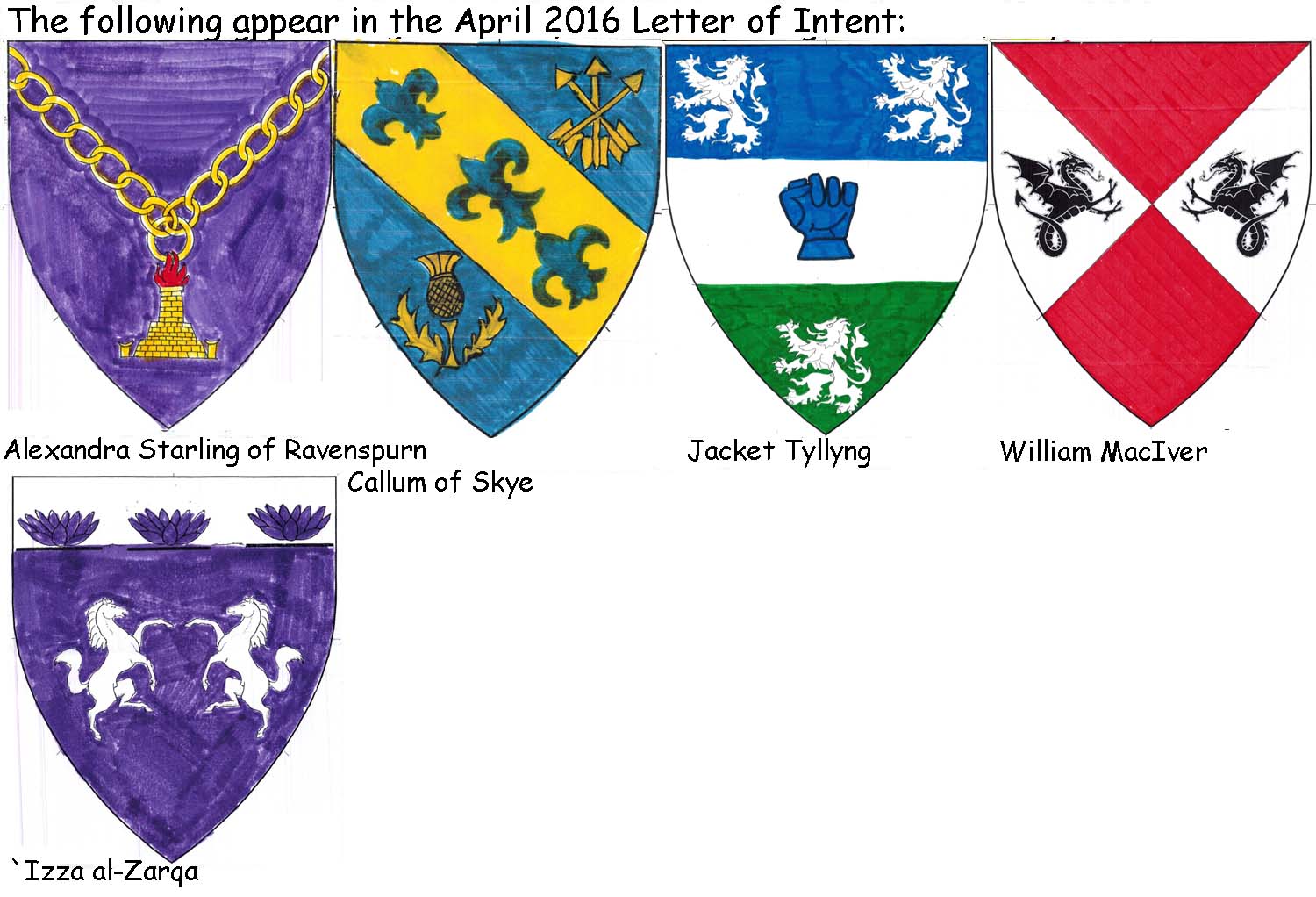
Kingdom of Atenveldt
Heraldic Submissions Page
(administered by the Brickbat Herald)
|
HATENVELDT COLLEGE OF HERALDS Letter of Intent 20 April 2016, A.S. L
Unto Andrewe Laurel; Lillia Pelican; Brunissende Wreath; and the commenting Members of the College of Arms, Greetings from Marta as tu Mika-Mysliwy, Brickbat Herald and Parhelium Herald for the Kingdom of Atenveldt!
The Atenveldt College of Heralds requests the consideration and registration of the following names and armory with the College of Arms. Unless specifically stated, the client will accept any spelling and grammar corrections; all assistance is appreciated.
1. Alexandra Starling of Ravenspurn: NEW NAME and DEVICE Purpure, pendant from a chain set in chevron inverted a lighthouse Or, enflamed gules.
Alexandra is a female given name dated to 1205 in England (Withycombe, 3rd edition, p. 14 s.n. Alexandra). Starling is dated to 1166 and 1203 for Wimund Starling (Reaney and Wilson 3rd edition, p. 425). Ravenspurn was a town in the East Riding of Yorkshire, England, which was lost due to coastal erosion, one of more than 30 along the Holderness Coast which have been lost to the North Sea since the 19th century. The town was located close to the end of a peninsula near Ravenser Odd, which has also been flooded. Two medieval English kings landed at Ravenspurn: Henry IV in 1399, on his way to dethrone Richard II, and Edward IV in 1471, on his way back from exile in the Netherlands, where he was resisted by the local lord, Sir Martin de la See. (https://en.wikipedia.org/wiki/Ravenspurn). Ravenspurn is also mentioned in Ekwall under the heading Spurn Head as one of the variations of the name for the place (Ekwall references Shakespeare's Richard II).
2. Callum of Skye: NEW NAME and DEVICE Azure, on a bend between a sheaf of arrows inverted and a thistle Or, three fleurs-de-lys azure.
Callum is documented as a male given name, a form of Columb in Ó Corráin and Macguire's Irish Names, p. 55 (as Calum). There are several instances of this name in the familysearch.org site, notably with the marriage of Callum Kynach in 1643 in Kenmore, Perth, Scotland (https://familysearch.org/ark:/61903/1:1:XY3H-252, Batch M11360-2). Skye is the location of Dunvegan Castle, the oldest inhabited castle in Scotland and always by the same family, the chiefs of the Clan MacLeod. The MacLeods are one of the principal clans on Skye. The castle began in the 12th C. The MacDonalds, the other main clan on Skye, were not so settled. Around the 16th or 17th C., they moved their clan seat from Dunsgaith, near Tokavaig on Sleat, to Duntulm at the north of the Trotternish peninsula. (http://www.isleofskye.com/skye-guide/history). The client desires a male name and it most interested in the language/culture of the name. He would like it authentic for 12-16th C. Scottish (either language/culture or time period it acceptable).
3. Hunter du Grae: NEW NAME Hunter
is the client's legal middle name (DMV license copy to Laurel) via
SENA PN.1.B.2:
Modern "middle names" are a special case. Some people in
the modern world have middle names derived from given names. Others
have middle names derived from surnames, through shifts in naming
practice, through marriage, or for other reasons. Therefore, middle
names are registerable based on the type of name they are: given
names or surnames. Middle names which originated as surnames but are
modernly used as given names may be used as given names. The client desires a male name.
4. Jacket Tyllyng: DEVICE RESUBMISSION from Laurel, July 2014 Per fess azure and vert, on a fess between three lions argent a sinister gauntleted fist azure.
The name was registered July 2014.
The client's previous submission, Gules, on a mountain vert snow-capped a sinister gauntleted fist argent., was returned by Laurel “No documentation was provided, by the submitter or in commentary, that a snow-capped mountain is a period motif. Barring such documentation it is not registerable to the submitter as the grandfather clause applies to the Barony of Ered Sûl, but does not extend to the residents of the Barony.” This is a redesign using elements of the previous submission.
5.
William MacIver:
NEW NAME and NEW DEVICE Ogress
Herald comments: “All the forms in Black are Scots. William
is a perfectly good Scots given name, being found, among other
places, in Aryanhwy merch Catmael's "Index of Scots names found
in Dictionary of the Older Scottish Tongue,"
(http://www.ellipsis.cx/~liana/names/scots/dost/william.html),
with 208 instances of this spelling between 1392 and 1650.” 6. `Izza al-Zarqa': NEW DEVICE CHANGE Purpure, two horses combatant and on a chief argent three lotus blossoms in profiles purpure.
The name was registered July 2012.
If this submission is registered, please release the currently-registered device, Purpure, two horses combattant and a chief Or.
Aria Gemina Mala comments that an
artist's note would be appropriate (and I agree), that the lotus
should float mid-chief as is usual to better identify the charges. There are 4 New Names, 3 New Devices and 1 New Device Change; there is 1 Device Resubmission. There are 8 items chargeable and a total of 9 items. Laurel should receive $12 for new submissions.
I was assisted in the preparation of this Letter of Intent by Alys Mackyntoich, Andreas Lucernensis, Aria Gemina Mala, Arwyn of Leicester, Hubert de Stockleye, Song Zidie and Sorcha inghen Chon Mhara.
Thank you to those who have provided your wisdom and patience, your expertise and your willingness to share it.
|
This page is best viewed with a minimum of 800 x 600 resolution, and 16 million colors.

